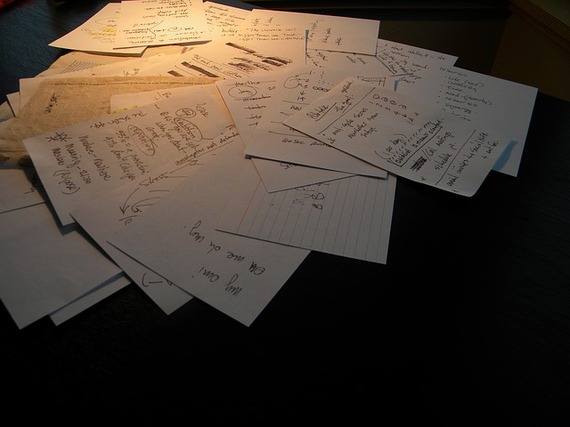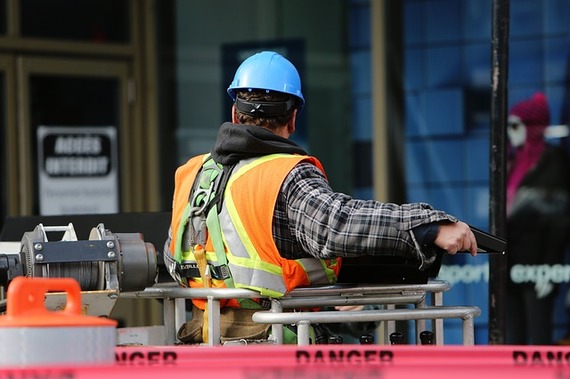
Do you snicker when you hear the term "work-life balance?" As if. That elusive Zen zone can provoke anxiety, especially to those of us whose perfectionism tells us if we try harder, we'll find it. After 55 minutes of trying to force myself to relax in last week's yoga class, I finally found almost 6 full seconds of unfocused focus time before my mind snapped back to the 36 tasks still waiting for me the moment I rolled up my mat. The average attention span of today is 8 seconds, so I was close. A good effort, all things considered.
Is "balance" a fallacy? Maybe you get stressed at the mention. The term can take on a shaming tone-like it's all just a matter of sheer individual will and not at all connected with our archaic work environments where "quality of life" is just as much a myth. "Balance" becomes one more thing we think we're not on point with. We overlook that our world of work has become risky business for all of us.
Work-life risk. Work-life chaos. Work-life spillover. Work-life burnout. More like it.
An American Psychological Association study reveals 1 in 5 of us don't realize the extent of our stress until we physically show symptoms. Emergency rooms are flooded with people having heart attacks or pseudo-ones turning out to be panic episodes. In New York and Los Angeles, heart attacks are seen as work related injuries.
We're clobbered to the point of serious harm, and often don't realize the severity until our brains and bodies cry "Uncle", and we're sitting in the waiting room. A friend of mine whose adrenal overload landed her in the hospital told me the three days off was like a mini-vacation. She said she even felt a little more balanced. Help us.
The pressure is getting to us, with job stress taking the cake as the number one source of strife for adults in America. We're desperately trying to find balance in the unbalance. Maybe it's institutional and societal policies and conditions that need recalibration, not just us searching for balance on our yoga mats.
Few of us are in a situation where there's much give. Paid leave and vacation days are scarce, and the proposition of taking time off can prove stressful because of the inevitable game of catch up we'll never win. We can't always move the elephants in our office rooms-the stubborn, large and often unspoken aspects of our organizations and culture at large that suck our lifeblood dry. Our quest for productivity and efficiency ends up stomping out our joy and creativity-the very things we need to inform our work.
The level of responsibilities and demands seem inescapable-they are part of the set of occupational hazards we face today. But superficial ideas about balance are leaving us unprotected instead of getting to a better place.
The dangers are sometimes intangible-we don't see the long hours, frenetic pace and constant adrenaline as that unusual. Most of us have worked at a breakneck pace for as long as we can remember, and even enjoy the perks-the sense of accomplishment, pride and identity it brings. That's what makes protecting ourselves a little trickier than jobs where industrial risks are clearly established and accounted for.
Construction workers, for example, would be considered foolish to step onto job sites without their signature hard hats and goggles. OSHA works hard to prevent the most common accidents known as the "fatal four": falls, electrocutions, getting struck or pinned. Workers have to put on their protective gear, but it doesn't stop there. Those in charge also need to create safe conditions, and are penalized when they neglect to do so.
We may not be at risk for getting crushed or hit by falling objects, but stress-related illness is wreaking havoc on millions. And even with the right gear, dangerous work sites are likely to harm us. Together, employees and employers need to protect against our own version of the "fatal four": health risks, adrenal overload, constant spillover and burnout.
Here's a start:
1. Put your hard hat on. Self-care is our "hard hat", the protection we need to avoid getting walloped from stress. Research shows when we prioritize our brains, bodies and spirits, we feel and do better. Neglect leads to demoralization, burnout and ill health. Don't show up to work without protection. Bring your go-to strategies: micro breaks, walking meetings, positive mantras, setting boundaries and connecting with your fellow workers.
2. Speak up. If your organizational culture is sucking the life out of good people, see what can be done. Tell them rigid, 24-7, always-on, no time-for-life doesn't work. Show them the data. Some companies are kind enough to listen because of their concern for human well-being; but all tend to listen when it comes to the financial bottom line. Absenteeism, turnover and what Tufts researchers are calling "presenteeism", or you're here but you're not, accounts for 15-20% lost productivity each year.
3. Unglue yourself from your desk. Keep your body moving. Our sedentary lifestyles are not serving us well, and is now being called "sitting disease". Research shows if we sat 3 hours less a day, it would add 2 years to life expectancy. Walking and running help lower anxiety and depression. In heart disease, stroke, cancers and diabetes -- sitting disease is cited as a key risk factor.
4. Shut down. Our brains need respite from the barrage of messages flooding our circuits. Sleep is paramount for mood, memory, focus and sustaining our well-being. Healthcare consulting firm Vynamic coined the term "zmail", a blackout zone between 10pm - 7pm. The German labor ministry has banned work outside of business hours except for emergencies to help stave off burnout.
5. Reach out. Don't leave resources on the table. Be savvy-don't wait to use your Employee Assistance Program (EAP) until you are burnt. Gone are the days we see therapy as a last resort. We now have the data that proves prevention is the best route. A study by Chestnut Global partners suggest we have a long way to go-usage rates are climbing, but still at a low 4.5%. Many EAP's are expanding services to include coaching, financial advising and virtual resources and hotlines for immediate support.
What would happen if corporations and organizations created safer cultures for employees, encouraging them to wear their hard hats, and simultaneously creating safe and supportive work conditions? We need a melding of collective action to foster healthier people, organizations and societies. That's the kind of balance we need to talk about.
Dr. Kristen Lee Costa is a behavioral science professor, therapist and author of Reset: Make the Most of Your Stress, named motivational book of 2015.
#onlywe

